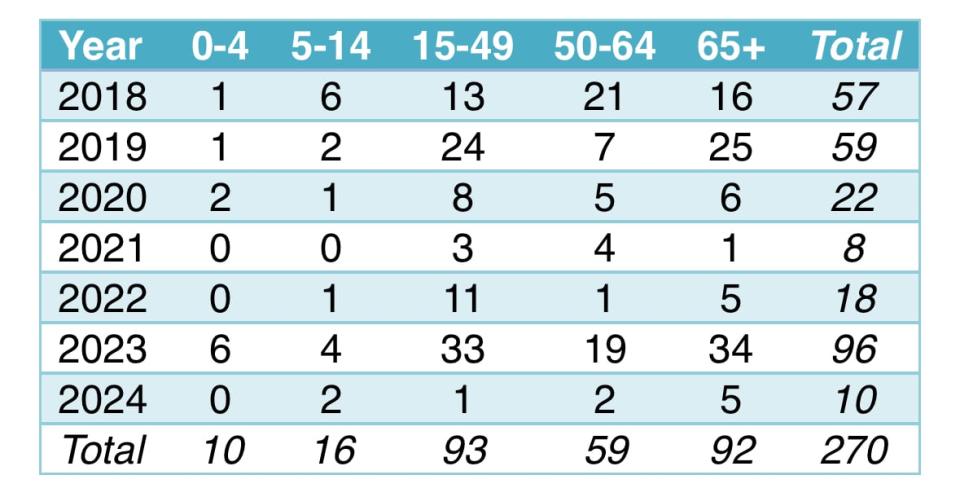Cases of aggressive form of strep on the rise in Nova Scotia

Cases of invasive group A strep — a bacterial infection that can be deadly — are on the rise in Nova Scotia, according to figures provided by Nova Scotia Health.
According to the data, there were 96 cases last year, compared to 57 cases in 2018. There have been 10 cases so far this year.
Invasive group A streptococcal disease occurs when the common strep A bacteria spreads beyond the places it typically infects (such as the throat or skin) into sterile parts of the body, such as the bloodstream or the liquid around the brain, or into soft tissue, where it can cause necrotizing fasciitis, known as flesh-eating disease.
Dr. Ryan Sommers, the senior regional medical officer of health at Nova Scotia Health, notes that the trend is not unique to the province.
The Public Health Agency of Canada has said more than 4,600 cases were confirmed in 2023 at the National Microbiology Lab in Winnipeg, an increase of more than 40 per cent over the previous yearly high in 2019.
The CBC's Mainstreet spoke with Sommers about what's driving the increase, and how to protect yourself.
Tell me about the number of cases we've seen in this province over the last few years.
In this past year, we've seen an increased number of cases of invasive group A strep in our province. Interestingly, we had some of the lowest rates during the first three years of the pandemic. As you may recall, during that time, one of the public health measures we used was to decrease the number of interactions with people. What we found was that those same measures prevented the spread of all kinds of other communicable diseases, so we saw a drop in invasive group A infections. And then as of mid-2022, with the removal of the public health measures throughout the world, we saw an increase in the number of cases of invasive group A strep. So we started seeing signs of this in places like the United Kingdom in the fall of last year and we've seen the trend continue in other parts of the world now too.
What age groups are we seeing affected by group A step?
Here in Nova Scotia, our trend has been primarily seeing disease in those over the age of 65. With this disease, the pattern usually is that the extremes of ages, so children under 5 and then those over 65, tend to be prone to getting it. And also those individuals who have certain chronic diseases or weakened immune systems. Young children are still developing their immune systems and they haven't been exposed to these infections in the past. And as people get older, their immune system doesn't work as well, or they have other chronic conditions that doesn't allow their immune system to function as properly. So those are the groups that are most at risk in terms of deaths in Nova Scotia.

This table shows the number of Group A strep cases in Nova Scotia since 2018. (Nova Scotia Health)
Is it normal to see cases as high as we did last year?
In the past, we've had times where we've seen more activity in those certain populations. What makes the past year or two interesting is, first of all, there's a lot of kids who weren't exposed to infections during the high point of the pandemic, so we did see a lot more of invasive group A strep. But probably the most important thing we saw in 2022 and from 2023 to 2024 is that a lot more people are getting viral infections. We know viruses like COVID-19, influenza virus and RSV — when you get those, you can be predisposed to getting a bacterial infection. Your immune system is busy fighting a viral illness and then a bacterial illness can come in and cause disease as well. So probably it's a combination of factors. We had a really busy flu season last year. So as more people get exposed to viruses, there's also a higher chance of them getting these secondary bacterial infections at the same time.
We've already seen 10 cases so far this year. Is that normal?
This year has been a little bit higher than than last year. It was interesting that other jurisdictions, they saw peaks in their invasive group A strep in the fall of 2022. We didn't have that same type of increase. We've definitely seen more of it now in the 2023-2024 year. What we're seeing this year is a typical flu season that matches the trends pre-pandemic. Flu seasons can start as early as November in the Maritimes and then sometime around the end of December and January is when we see peak numbers. Couple that with the holidays, when we have more people gathering together, we tend to see a lot more disease activity when it comes to the viral infections.
How can we mitigate the risk of getting group A strep?
The first thing to realize is that group A strep is a common bacteria. It's part of the natural flora that exists in humans. The biggest thing to do is to be educated and be aware of the red flags. So what we tell people is if you have a fever that's getting progressively worse, if you have someone — it could be a child or older person — that is not drinking as much, has decreased food intake or not producing as much urine as they usually do, or if they get more sleepy, lethargic, or they have a rash that's worsening, those are big red flags that something else is going on and should be investigated by a health-care provider. Invasive group A strep infections can come on quickly, so it really is important to get assessed if someone has these worsening signs and symptoms. Having a viral infection before this can predispose someone to getting the bacterial infection, so we encourage people to be up to date on their annual vaccines, in particular the COVID-19 and influenza vaccines.
MORE TOP STORIES

